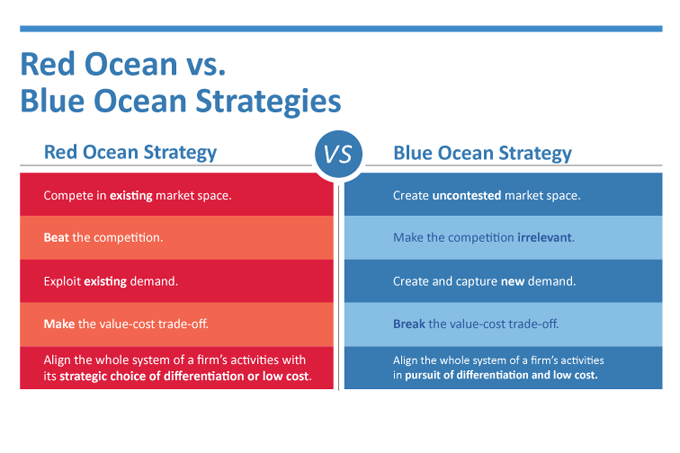- Mail:
- info@digital4pro.com
Kim and Mauborgne’s Blue Ocean Strategy

La Blue Ocean Strategy di Kim e Mauborgne
5 Agosto 2020
I 4 elementi abilitanti per lo sviluppo delle reti 5G
11 Agosto 2020Rather than competing within the confines of the existing industry or trying to steal customers from rivals (Bloody or Red Ocean Strategy) W. Chan Kim1 and Renée Mauborgne2 suggest the Blue Ocean Strategy: the development of undisputed market spaces that makes competition irrelevant .
Kim and Mauborgne, in the HBR of October 2004, indicate that competing in overcrowded sectors is not a way to sustain high performance; the real opportunity is instead to create blue oceans of uncontested market spaces.
Kim and Mauborgne argue that although traditional competition-based strategies (red ocean strategies) are necessary, they are not sufficient to sustain high performance. Companies must go beyond the competition. To seize new profit and growth opportunities, they also need to create blue oceans. The authors argue that competition-based strategies assume that the structural conditions of an industry are given and that companies are forced to compete within them, a hypothesis based on what academics call the structuralist view, or environmental determinism.
The innovation of value
A fundamental component of the Blue Ocean Strategy is the innovation of value, a concept originally outlined in Kim & Mauborgne’s 1997 article “Value Innovation – The Strategic Logic of High Growth”3. The innovation of value is the simultaneous search for differentiation and low cost, creating value both for the buyer and for the company and its employees, thus opening up new and incontrovertible market spaces.
The goal of value innovation is not to compete, but to make competition irrelevant by changing the playing field of strategy. The strategic move must increase and create value for the market, simultaneously reducing or eliminating features or services less appreciated by the current or future market.
The framework of the actions envisaged by the Blue Ocean Strategy is used to help create value innovation and break the value-cost compromise. Value innovation challenges Michael Porter’s4 idea that successful companies are low-cost suppliers or niche players. Instead, the blue ocean strategy proposes to find a value that exceeds the segmentation of the conventional market and the offer of lower value and costs.
Charles W. L. Hill5 proposed a similar idea in 1988 and claimed that Porter’s model was flawed because differentiation can be a means for companies to achieve low cost. He proposed that a combination of differentiation and low cost might be necessary for businesses to achieve a sustainable competitive advantage.

Figure 1 – Red Strategy and Blue Ocean Strategy [Source: blueoceanstrategy.com].
Red ocean strategy
The red oceans represent all the industries existing today in the known market space. In the red oceans, the boundaries of the sector are defined and accepted and the competitive rules of the game are known. Here companies try to outperform their rivals to grab a larger share of demand for products or services. As the market space becomes crowded, the prospects for profits and growth decrease. Products become raw materials or niche and fierce competition turns the ocean into bloody. Hence the term “red oceans”6.
To support themselves on the market, practitioners of the red ocean strategy focus on building advantages over the competition, usually by evaluating what competitors are doing and trying to do it better. Grabbing a larger share of the market is seen as a zero-sum game in which the gain of one company is achieved at the loss of another company. Thus, competition, the supply side of the equation, becomes the distinctive variable of the strategy. Cost and value are seen as compromises and a company chooses a distinctive cost or a differentiation position. Since the total profit level of the sector is also determined by structural factors, companies mainly try to capture and redistribute wealth instead of creating wealth. They focus on the division of the red ocean, where growth is increasingly limited.
Blue ocean strategy
The blue oceans, on the contrary, denote all the industries that do not exist today, the unknown market space, uncontaminated by competition. In the blue oceans, demand is created rather than fought. There is ample opportunity for growth that is both profitable and rapid. In the blue oceans, competition is irrelevant because the rules of the game are waiting to be set. The blue ocean is an analogy to describe the wider and deeper potential of the market space that has not yet been explored.
The blue ocean strategy is based on the fact that the market boundaries and the structure of the sector are not given and can be reconstructed by the actions and beliefs of the sector operators. This is what the authors call the reconstructionist view. Assuming that market structure and boundaries exist only in the minds of executives, the operators who support this view do not let existing market structures limit their thinking. For them, the extra demand is out there, largely untapped. The crux of the problem is how to create it. This, in turn, requires a shift of attention from demand to supply, from attention to competition to attention to value innovation, or the creation of innovative value to unlock new demand. This is achieved through the simultaneous pursuit of differentiation and low cost. By expanding the demand side of the economy, new wealth is created. This strategy therefore allows companies to play largely a non-zero sum game, with high payoff possibilities.
Conclusions
Competition is important, but focusing on competition and competitive advantage can make you lose sight of the strategy.
In the blue oceans the demand is created. There is ample opportunity for growth that is both profitable and rapid.
¹ W. Chan Kim è Boston Consulting Group Bruce D. Henderson Chair Professor of Strategy and International Management presso INSEAD business school e co-direttore dell’INSEAD Blue Ocean Strategy Institute.
² Renée Mauborgne è INSEAD Distinguished Fellow e professore di strategia all’INSEAD, una delle migliori scuole di business del mondo. È anche co-direttrice dell’INSEAD Blue Ocean Strategy Institute.
³ https://hbr.org/2004/07/value-innovation-the-strategic-logic-of-high-growth
⁴ https://en.wikipedia.org/wiki/Michael_Porter
⁵ https://en.wikipedia.org/wiki/Charles_W.L._Hill
⁶ https://web.archive.org/web/20081203070029/http://www.insead.edu/alumni/newsletter/February2005/Interview.pdf
Bibliografy:
- https://www.blueoceanstrategy.com/
- https://en.wikipedia.org/wiki/Blue_Ocean_Strategy
- Blue Ocean Strategy, W. Chan Kim, Renée Mauborgne




